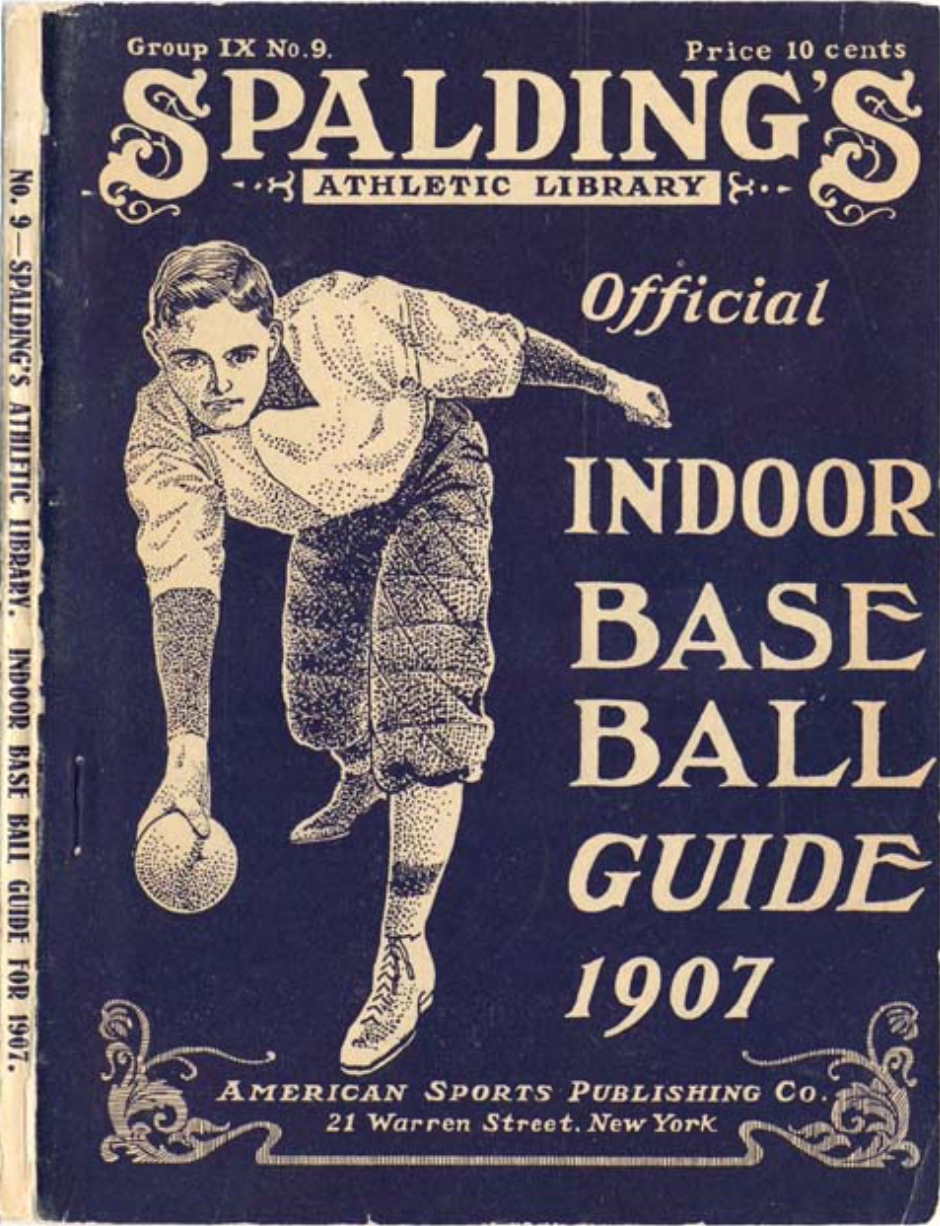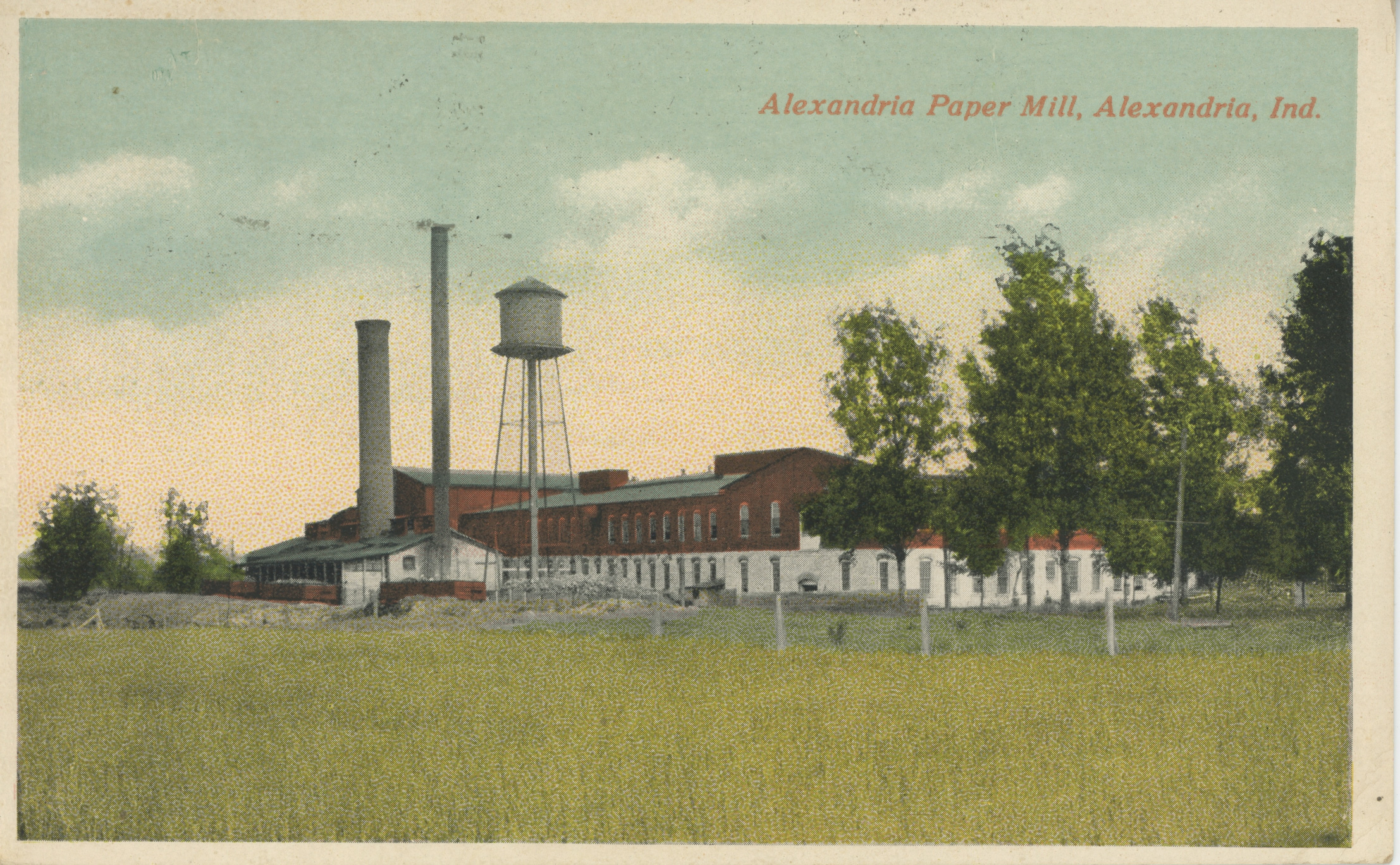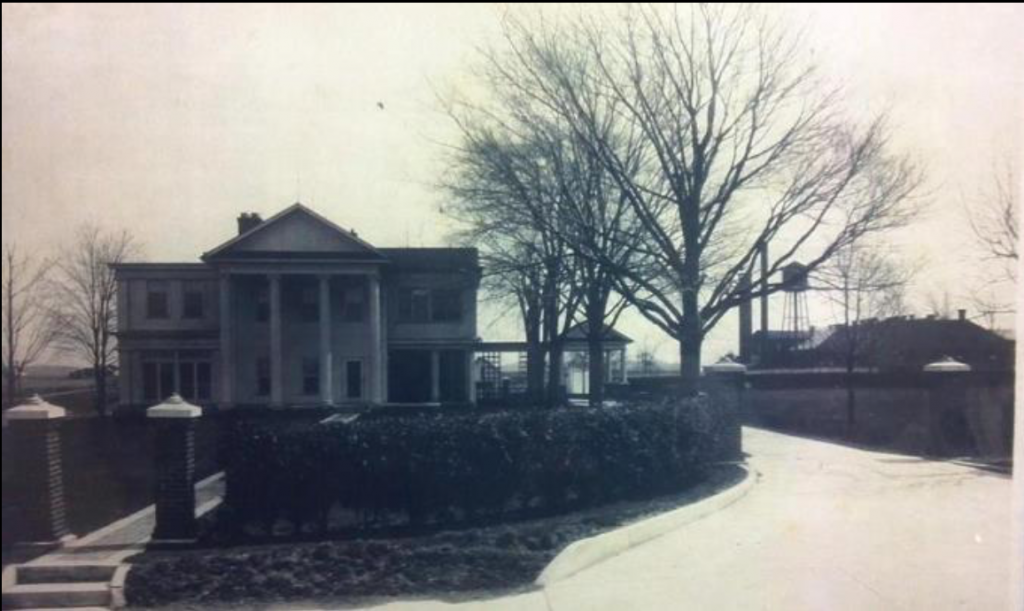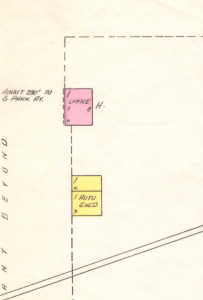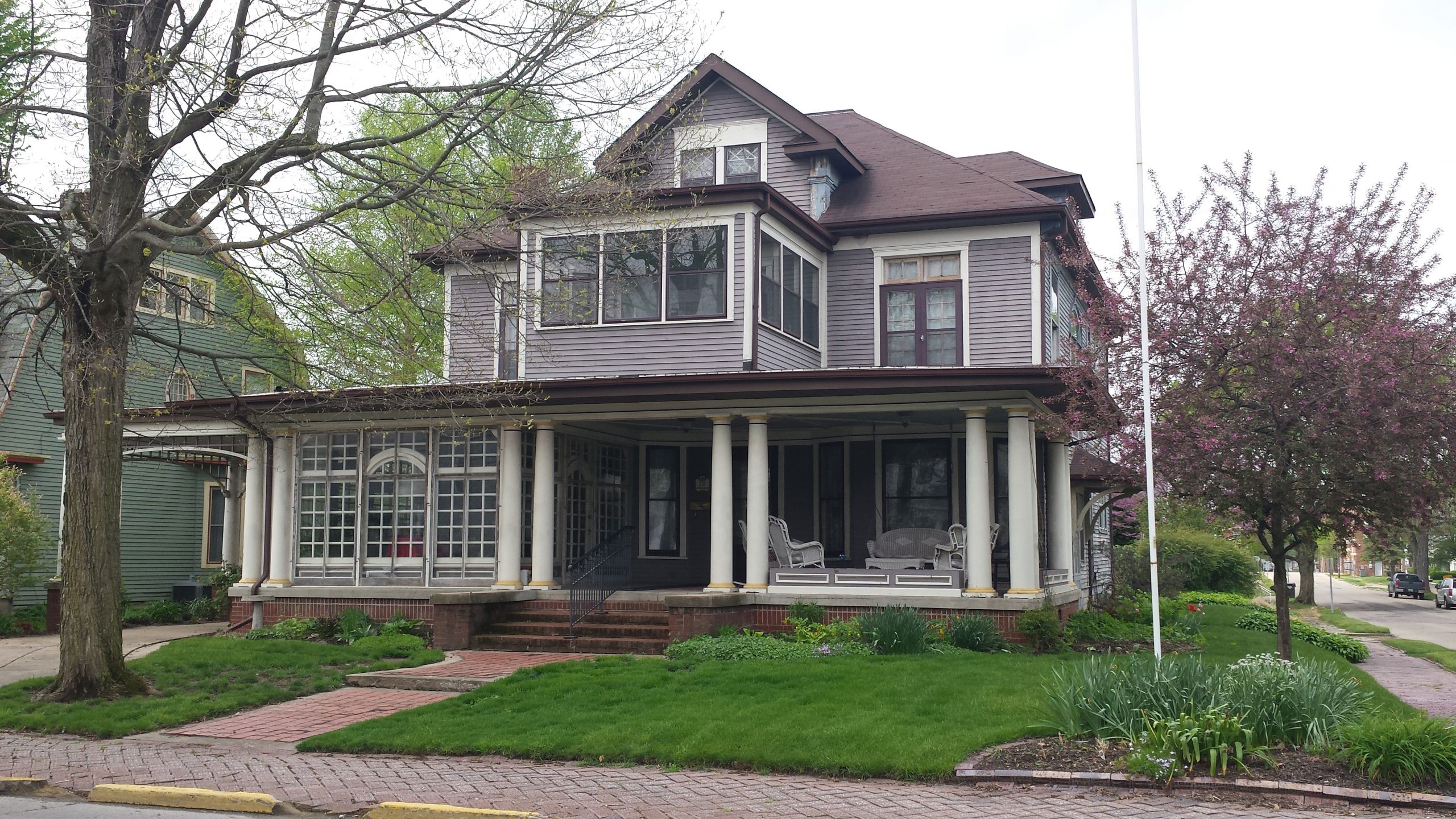The Alexandria Paper Co. Campus
The next few years flew by. Working first as secretary then vice-president and general manager of the Alexandria Paper Mill, Harry Cook was often on the road for business…and pleasure. His position offered him the luxury to spend a few months in Florida joined by his sister and in later years his father, S. A. An avid sportsman, he enjoyed attending sporting events all over the country, and when he was not a spectator, he was a talented and competitive participant.
In October of 1911, Georgina Yule prepared to make a trip home to Canada. The timing of her visit got Ed Yule and Harry thinking. They gallantly offered to escort Georgina as far as New York City, where they would stop to witness the opening game of the World’s Series. The New York Giants battled the Philadelphia Athletics in the Game 1 opener which occurred on October 14th before a record attendance of 38,281 fans. “Baseball was fast becoming more than just another entertainment spectacle. Soon it would officially be christened ‘America’s national pastime.’”
It certainly was a favorite sport in Alexandria, as early as 1905 Sunday games were a popular past-time. Harry brought his love of the sport to the paper mill by introducing indoor baseball, which he played on the mill’s tennis court. “Indoor baseball is played almost the same as the outdoor game, except that a smaller bat and a larger ball are used, and the pitcher merely tosses up the ball instead of putting on the speed and curves which are such an important part of the regular game.”
Harry was always ready to put together a friendly game. During one such game on November 19, 1911, Joe Lauderdale, “colored chauffeur for Harry” attempted to make a “Ty Cobb steal of third base when his feet became tangled and he fell heavily to the ground,” breaking his leg above the ankle.
The mill also boasted an outdoor field, and Harry was known to “call men from their jobs to play ball on the lawn west of the factory gates.”
In May of 1913, the paper mill was again evaluating what would be the most efficient fuel with which to run the plant, and it was determined that switching to steam would reduce the fuel bill by twenty percent. This also required a new “steel stack one hundred and twenty feet high” to be erected “at a cost of $4,000.”
Two months later a massive lightning storm blew over Alexandria. Lightning struck the recently erected steel water tank and shattered a portion of the roof. Another bolt struck the office and demolished a desk, while a third lightning bolt struck the house, but thankfully no serious damage was done.
Our first up-close look at the home is in 1914 when the Yule’s celebrated George Washington’s birthday with a euchre party at the house. “The home was decorated in the national colors with small silk flags and figures of Washington scattered throughout the living rooms. The tally cards were hatchets and the favors consisted of little hatchets with cherries attached. Numerous vases of beautiful flowers adorned the rooms. A four course luncheon was served.” They invited 22 people. Euchre is a game typically for four players, so they would either have set up six tables for play, or three tables for play rotation.
What did the house look like? The article mentions “living rooms.” So, we can assume more then one parlor for entertaining. We know the home had at least three bedrooms, as it was home to the Ed Yules and Harry Cook. Frequent guests were Harry’s sister, Maud, and her husband Charles Lancaster. Harry’s father. S.A. Cook would occasionally come for an extended stay. My guess is that Harry would stay in his rented rooms in Alexandria when the whole family was in town.
In May 1915, Harry, vice president of the Rolling Mill Land company, along with Ed Yule, secretary, petitioned the Alexandria city council for the dis-annexation of five acres located between Fifteenth and Seventeenth streets, and Harrison and Wayne streets in the south-part of the city. This five acres was part of a purchase the company had made in 1906. Was this the start of what would become the Alpaco Farms? (Alpaco = Alexandria paper company).
In September The Times=Tribune reported that “Under the direction of Harry Cook…a number of repairs are being made on the country home occupied by Mr. and Mrs. Edwin Yule adjoining the paper plant. The driveway of the home will be beautified with a fence separating the spacious lawn to the south of the country home. A flag pole has been erected in the far south corner of the indoor baseball diamond. When completed the home will be one of the prettiest around Alexandria.”
October saw the end of the 1915 baseball season. Almost a thousand fans crowded into Westside Park on October 31st to watch the final match between the Alexandria Paper Mill Team and the Marion Boosters. “At the end of ten long innings Manager Doyle (of the Marion Boosters) was forced to load his ball players into a traction car with the small end of a 4 to 3 score.” “By defeating Marion…the Alexandria club made a record this season that is hard to beat. Out of twenty-eight games played with some of the fastest semi-professional teams in the state…the club won twenty-two and only lost six.”
To celebrate the end of this amazing season of baseball, Harry hosted the team at a six o’clock dinner at the “country home of Mr. and Mrs. E. W. Yule.” Mayor J. S. Wales was scheduled to be the “chief orator” for the evening, but he had lost his voice while attending the game. The “tenth inning excitement was too much,” and he lost his voice, only a whisper could be heard.
The banquet and the home were described like this: “A menu of turkey and all the trimmings reminded the ball tossers of Thanksgiving. It was an old fashioned turkey dinner prepared by the famous colored a la carte cateress, one Fannie Judy…the service resembled the Louis XIV dining room at the Claypool.” The Claypool was a grand hotel in Indianapolis.
Who was Fannie Judy? A year later when she passed away from a heart attack at the age of 45, her obituary describes her this way: “Fannie Judy’s name was a household name in many Alexandria homes. She was known for her ability as a cateress in serving the finest dinners. As a cook she was hard to beat. When a social event of any consequence was arranged in this city and it was decided to serve a meal, the first name suggested was Fannie Judy. Her fame in the kitchen was spread to Elwood and frequently she was seen with a heavily laden basket enroute to the west Madison county town where she was to serve dinner.” She “could always be depended on to help make an evening a pleasure for the invited guests.”
The Alexandria Paper Company continued its quest to acquire additional acreage in eastern Indiana, as in January 1916 136 acres were purchased in Monroe Township for $22,720. S. A. continued to hold the 16 acres that the house sat upon as personal property, which had a tax value in 1916 of $4,155.
Harry announced that after June 12, 1916 the mill would be moving from a 12-hour to an eight-hour shift model. This would increase the number of employees by 50, and the number of working crews from two to three. This announcement was a “source of satisfaction for employes.”
Lightning again struck the mill on August 4th and burned out some fuses. At 4:30 a.m. Harry was awakened by the shock, and looking out his window “saw a ball of fire as large as a ballon cavorting in a zig-zag manner along the wire.” To see the mill, his rooms would have been at the back of the house.
“Alexandria’s Show Place” is what The Times=Tribune called the paper mill campus on September 26th. “Every town and every city has its so-called ‘show place,’ the one outstanding place of interest to which the citizens point with pride when showing guests and strangers the outstanding features of interest and advantage possessed by their home town.” In Alexandria, this “show place” was the paper mill. “A natural beauty spot, the factory site has been enhanced by artificial means until today it is a veritable park. The ornamental brick posts, topped by large white globes, inclosing electric lights, give an aristocratic aspect to the place. The home of the resident manager, Mr. Ed Yule, is nearby, giving the entire place a homelike and comfortable appearance A new port cochere is now being constructed on the south side of the residence which, when completed will greatly add to its attractiveness.” “A fine sight is to view the mill at night, the myriad of lights giving it the appearance of unusual significance.”
On November 16, 1916, two garage buildings were destroyed by fire following an explosion of gasoline. Joseph Lauderdale, the mills chauffeur, sustained burns on his arms. He had been using gasoline to rub grease from a pair of trousers, and it was supposed that the friction had caused a small explosion. Joe braved the flames to safely back out two automobiles that were stored in the garage. The local fire department attached a line of hose to the water tower at the factory and they were able to draw 75 pounds of water pressure, but the structure was a total loss. Several tires were lost in the fire, but thankfully the feed nozzle for the 200-gallon underground gasoline tank could be turned off and was made safe from further explosion. The fire chief estimated the loss at $400, and the “Alexandria Paper Company will give a banquet at an early date in honor of the firemen who fought the stubborn garage fire.”
The newspapers were always quick to report on Harry’s comings and goings, and he was making countless trips to Neenah to “visit his father.” I believe that there was another reason for so many trips home, he was courting Martha Wheeler Paine of Oshkosh, Winnebago County. Martha was the daughter of Edward Wheeler Paine and Elizabeth May Hosford. The Paine’s were a pioneering family of Oshkosh, and Martha’s grandfather, George Milton Paine, was the founder of the Paine Lumber Company which in 1917 was known as the “largest sash and door mill in the world.”
Another clue that change was in the air was the January 1917 announcement that Ed and Georgina had purchased a home at 212 Lincoln Avenue in Alexandria. They planned to move in as soon as the home was available.
With the resignation of Jack Yule, elections were held to make the adjustment in management needed to move forward. S. A. “who is known among paper manufacturers all over the United States,” remained president, Harry as the “recognized head of the plant,” vice-president, Charles Lancaster, who recently had been appointed the head of the real estate department, secretary, and Edwin Yule, “who has been connected with the concern for a number of years,” treasurer. Charles also became a member of the board of directors.
Upon taking this new management role, Charles and Maud decided to acquire a permanent residence in Alexandria. They purchased, or rented, a home “near the Alexandria Paper Mill factory” and in April 1917 started “improvements amounting to several thousand dollars” on the home. The exact location of the home has not yet been determined.
Patriotism was deeply rooted in the Cook family, so it was only natural that as the United States officially entered World War I, S. A. would announce a flag-raising ceremony at the paper mill. The date was set for April 17th. I have documented this momentous event in a post titled: A Forgotten Family. Click the title to read.
The creation in 1915 of the Hoosier-Dixie Highway encouraged the citizens of Alexandria to take great pride in the appearance of their property. By 1917 flowers were planted and front yards were being maintained. Motorists approaching from the south passed the paper mill where “in the last year much improvement work has been done and the country home at the mill is noticed by the traveling fraternity. H. H. Cook has stated that a number of other changes will be made early this summer.” The Times=Tribune reported on May 28th that Harry was building a private golf course, that he was “laying out a course of nine holes near the paper mill.”
As work continued on the country house, thirty-six-year-old Harry had moved into his rooms in the Day building and was soon joined by his sister and brother-in-law as worked progressed on their new home.
On June 22nd The Times=Tribune reported that they had received news “that was a surprise to many Alexandria friends.” Harry Cook was to be married to Martha Wheeler Paine. “Before leaving for Chicago this morning, where he was to meet Miss Paine and a party of friends, Mr. Cook was reticent concerning the wedding.”
The wedding took place at on June 30, 1917 at 11:00 a.m. in the Paine living room. 22-year-old Martha was given away by her father, and the ceremony was performed by her uncle, Rev. Francis L. Palmer. There were no bridal attendants “The house was beautifully decorated in a simple scheme, using spring flowers. Syringa blossoms and pink peonies were combined in the living room and the bride’s table in the dining room bore an exquisite arrangement of white sweet peas. The bride wore a simple afternoon gown of white chiffon and carried white orchids.” “The young couple left early this afternoon for New York city and will go from there to Maine and Canada for about a month. They will reside at Alexandria, Ind.”
NOTE: I have turned off Comments for this post as I am being hit with spam. If you would like to comment, please do so through my Contact Me page, I would love to hear from you.
SOURCES:
- “Woman’s World,” The Times-Tribune, 20 Oct 1911, Friday, p. 1, col. 2; digital images, Newspapers.com (www.newspapers.com : accessed 17 Jun 2016).
- https://www.baseball-almanac.com/ws/yr1911ws.shtml : accessed 4 Sep 2021.
- “Indoor Game is Popular,” The Times-Tribune, 2 Jul 1912, Tuesday, p. 3, col. 1; digital images, Newspapers.com (www.newspapers.com : accessed 5 Sep 2021).
- “Lauderdale Broke His Leg.,” The Times-Tribune, 20 Nov 1911, Monday, p. 2, col. 3; digital images, Newspapers.com (www.newspapers.com : accessed 4 Sep 2021).
- Sue Marston, “Old Paper Mill Will Again Have A Heart Beat,” The Times-Tribune, 15 Apr 1970, Wednesday, p. 8; digital images, Newspapers.com (www.newspapers.com : accessed 19 May 2016).
- “A Money Saver,” The Times-Tribune, 9 May 1913, Friday, p. 1, col. 2; digital images, Newspapers.com (www.newspapers.com : accessed 20 Jun 2016).
- “Brief City News. Damage at Paper Mill–,” The Times-Tribune, 29 Jul 1913, Tuesday, p. 4, col. 4; digital images, Newspapers.com (www.newspapers.com : accessed 20 Jun 2016).
- “George Washington Party.,” The Times-Tribune, 19 Feb 1914, Thursday, p. 4, col. 3; digital images, Newspapers.com (www.newspapers.com : accessed 5 Jun 2016).
- “Garbage Master Kicked When a General Cleanup Was Suggested,” The Times-Tribune, 4 May 1915, Tuesday, p. 1, col. 1-2; digital images, Newspapers.com (www.newspapers.com : accessed 19 May 2016).
- “Ideal Country Home–,” The Times-Tribune, 1915-09-14, Tuesday, p. 3, col. 2; digital images, Newspapers.com (www.newspapers.com : accessed 27 May 2016).
- “Paper Mill Boys Take Marionettes,” The Times-Tribune, 1 Nov 1915, Monday, p. 4, col. 3; digital images, Newspapers.com (www.newspapers.com : accessed 7 Sep 2021).
- “Mayor Loses His Voice and Avoids Address at Ball Players’ Banquet,” The Times-Tribune, 1 Nov 1915, Monday, p. 1, col. 1-2; digital images, Newspapers.com (www.newspapers.com : accessed 17 Jun 2016).
- Ibid.
- “Mrs. Fanny Judy Dies Suddenly,” The Times-Tribune, 1916-11-02, Thursday, p. 1, col. 7; digital images, Newspapers.com (www.newspapers.com : accessed 7 Sep 2021).
- “Real Estate Transfers,” The Elwood Call Leader, 19 Jan 1916, Wednesday, p. 2, col. 4; digital images, Newspapers.com (www.newspapers.com : accessed 19 Jul 2016).
- S. D. Smith, President, Caron Directory Co.,Publishers, Louisville, KY, Caron’s Directory of the City of Anderson, Indiana And Taxpayers of Madison County for 1916-1917, II vols., II:, p. 744, (383 of 457); digital images, Ancestry.com (www.ancestry.com : accessed 1 Jul 2016).
- “Eight Hour Shift Will Start June 12,” The Times-Tribune, 3 Jun 1916, Saturday, p. 1, col. 2; digital images, Newsppaers.com (www.newspapers.com : accessed 17 Jun 2016).
- “Brief Local News. Lihgtning [sic] Strikes Wire–,” The Times-Tribune, 4 Aug 1916, Friday, p. 3, col. 1; digital images, Newspapers.com (www.newspapers.com : accessed 20 Jun 2016).
- “Alexandria’s Show Place,” The Times-Tribune, 26 Sep 1916, Tuesday, p. 1, col. 4; digital images, Newspapers.com (www.newspapers.com : accessed 20 Jun 2016).
- “Garage at Paper Mill Destroyed,” The Times-Tribune, 16 Nov 1916, Thursday, p. 1, col. 4; digital images, Newspapers.com (www.newspapers.com : accessed 20 Jun 2016).
- “Estimtaes [sic] Loss—,” The Times-Tribune, 17 Nov 1916, Friday, p. 3, col. 2; digital images, Newspapers.com (www.newspapers.com : accessed 18 May 2016).
- “E. W. Paine Passes Away At His Home,” (Oshkosh) The Oshkosh Northwestern, 30 Apr 1938, Saturday, p. 1, col. 7. Cit. Date: 5 Nov 2004.
- “Branum Property Sold To J. H. Benton,” The Times-Tribune, 27 Jan 1917, Saturday, p. 1, col. 4; digital images, Newspapers.com (www.newspapers.com : accessed 24 May 2016).
- “Annual Election of Paper Company.,” The Times-Tribune, 26 Mar 1917, Monday, p. 1, col. 6; digital images, Newspapers.com (www.newspapers.com : accessed 23 May 2016).
- Could this be the home that Ed Yule maintained in later years near the mill?
- “To Improve Home,” The Times-Tribune, 27 Apr 1917, Friday, p. 6, col. 2; digital images, Newspapers.com (www.newspapers.com : accessed 20 Jun 2016).
- “Hoosier-Dixie Highway is Cause of a Big Improvement Near Alex.,” The Times-Tribune, 6 Apr 1917, Friday, p. 1, col. 6-7; digital images, Newspapers.com (www.newspaper.com : accessed 19 May 2016).
- “Private Golf Course,” The Times-Tribune, 28 May 1917, Monday, p. 4, col. 4; digital images, Newspapers.com (www.newspapers.com : accessed 1 Sep 2021).
- The Times-Tribune, 2 May 1917, Wednesday, p. 3, col. 5; digital images, Newspapers.com (www.newspapers.co, : accessed 1 Sep 2021).
- “Manufacturer of Alexandria Will Wed Oshkosh, Wisconsin, Girl June 30,” The Times-Tribune, 22 Jun 1917, Friday, p. 1, col. 6-7; digital images, Newspapers.com (www.newspapers.com : accessed 18 May 2016).
- “Cook-Paine Wedding,” The Oshkosh Daily Northwestern, 30 Jun 1917, Saturday Evening, p. 4, col. 6; digital images, Ancestry.com (www.ancestry.com : accessed 14 May 2016), Newspapers & Publications.
